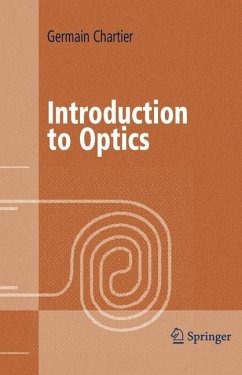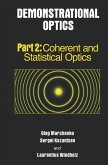Choice Outstanding Title! (January 2006)
Since the discovery of the lasers in 1960 and optical fibers in 1970, optics underwent deep changes which accentuated its multi-field character. This work covers essential concepts of comprehension and reports the great progress of current knowledge in optics. The method of presentation is inspired by Richard Feynman, with an emphasis on "telling" optics, rather than deducing it from fundamental laws. For its excellent teaching style, the book received the Arnulf-Francon Award by the French Optical Society. The concepts are formulated in a way such that the necessary mathematical tools do not hinder comprehension of the phenomena. Global in vision, the book can also be used as a reference. In addition to the traditional aspects of optics, it includes the tools and methods currently used by researchers and engineers as well as explanation and implications of the most recent developments.
Since the discovery of the lasers in 1960 and optical fibers in 1970, optics underwent deep changes which accentuated its multi-field character. This work covers essential concepts of comprehension and reports the great progress of current knowledge in optics. The method of presentation is inspired by Richard Feynman, with an emphasis on "telling" optics, rather than deducing it from fundamental laws. For its excellent teaching style, the book received the Arnulf-Francon Award by the French Optical Society. The concepts are formulated in a way such that the necessary mathematical tools do not hinder comprehension of the phenomena. Global in vision, the book can also be used as a reference. In addition to the traditional aspects of optics, it includes the tools and methods currently used by researchers and engineers as well as explanation and implications of the most recent developments.
From the reviews:
"A thoroughly updated translation from the original French by Chartier (Institut National Polytechnique de Grenoble, France), the book is intended for advanced undergraduates or graduate students. However, a professional in a related field would also find it a superb introduction to the subject. The opening chapters on optics and electromagnetic waves are both clear and concise. The next few chapters survey the concepts behind geometric and wave optics. There are relatively clear mathematical derivations presented for this material. The explanation of the physics through words and diagrams is where this book really shines. It is obvious that the author has worked in the field for many years, and he describes the phenomena in comprehensible ways that bring the material alive. There is a brief chapter on the index of refraction and the mechanisms involved with propagation in materials. There are chapters on lasers, nonlinear optics, diffusion and scattering, and guided optics. A final chapter discusses Fourier analysis. An excellent book for anyone interested in an introduction to optics with an appropriate background in physics and math." -Choice, November 2005
"This book gives an introduction to modern optics at an advanced level. The unique approach ... will benefit both students and lecturers alike. ... The book is complete and very clear. ... The author tries new ways of presenting optics. For me, this is an interesting point of view. ... I recommend the book to teachers and professionals of optics. No doubt that it will be in all physics libraries in the future." (Michel Wautelet, Physicalia, Vol. 28 (4-6), 2006)
"This wonderfully useful book is a translation and update by the author of the 1997 Manuel d'optique. The style of writing is excellent ... . If I were planning or teaching a senior course in optics, Chartier's Introduction to Optics would be my guide and chosen text. ... A nice feature of thetextis that each chapter has been independently reviewed by senior practicing scientists and engineers. This enhances its currency as a modern practical text. ... Thoroughly recommended ... ." (Tony Moon, Australian Physics, Vol. 42 (6), 2006)
"Introduction to Optics covers both traditional topics as well as recent developments. ... The book is well organized in 13 chapters and also includes an index. ... This volume is recommended as a useful reference for advanced undergraduate and graduate students in optical physics and engineering." (Reva Garg, Optics and Photonics News, January, 2007)
"A thoroughly updated translation from the original French by Chartier (Institut National Polytechnique de Grenoble, France), the book is intended for advanced undergraduates or graduate students. However, a professional in a related field would also find it a superb introduction to the subject. The opening chapters on optics and electromagnetic waves are both clear and concise. The next few chapters survey the concepts behind geometric and wave optics. There are relatively clear mathematical derivations presented for this material. The explanation of the physics through words and diagrams is where this book really shines. It is obvious that the author has worked in the field for many years, and he describes the phenomena in comprehensible ways that bring the material alive. There is a brief chapter on the index of refraction and the mechanisms involved with propagation in materials. There are chapters on lasers, nonlinear optics, diffusion and scattering, and guided optics. A final chapter discusses Fourier analysis. An excellent book for anyone interested in an introduction to optics with an appropriate background in physics and math." -Choice, November 2005
"This book gives an introduction to modern optics at an advanced level. The unique approach ... will benefit both students and lecturers alike. ... The book is complete and very clear. ... The author tries new ways of presenting optics. For me, this is an interesting point of view. ... I recommend the book to teachers and professionals of optics. No doubt that it will be in all physics libraries in the future." (Michel Wautelet, Physicalia, Vol. 28 (4-6), 2006)
"This wonderfully useful book is a translation and update by the author of the 1997 Manuel d'optique. The style of writing is excellent ... . If I were planning or teaching a senior course in optics, Chartier's Introduction to Optics would be my guide and chosen text. ... A nice feature of thetextis that each chapter has been independently reviewed by senior practicing scientists and engineers. This enhances its currency as a modern practical text. ... Thoroughly recommended ... ." (Tony Moon, Australian Physics, Vol. 42 (6), 2006)
"Introduction to Optics covers both traditional topics as well as recent developments. ... The book is well organized in 13 chapters and also includes an index. ... This volume is recommended as a useful reference for advanced undergraduate and graduate students in optical physics and engineering." (Reva Garg, Optics and Photonics News, January, 2007)








